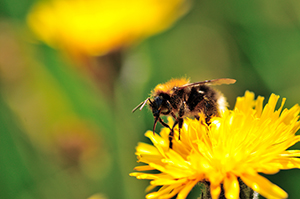
Pollinator declines. We’ve all heard the phrase, but what does it actually mean? I get this question all the time, and the answer is less straightforward than you might think. What evidence is there that these so-called “declines” are occurring? And are they occurring everywhere, or only in some areas with some particular species? These are the topics for our nineteenth “Notes from the Lab,” where we highlight “Widespread losses of pollinating insects in Britain,” written by Gary Powney and colleagues and published in the journal Nature Communications [10:1038 (2019)].
Powney and colleagues’ study takes advantage of two fantastic citizen science datasets. Specifically, the Bees, Wasps and Ants Recording Society (BWARS: http://www.bwars.com/) and the Hoverfly Recording Scheme (http://www.hoverfly.org.uk/). These datasets are comprised of pollinator observations by people just like you and me for the past several decades. The data are observations of a particular pollinator species on a given day at a given location — in the recorder’s backyard, during a weekend outing, etc. Though such observations may seem trivial on their own, a coordinated network of those observations is very powerful. In fact, if you didn’t already know, it’s these citizen science datasets that provide some of the best evidence in existence that pollinator declines are currently occurring. Indeed, it’s often not scientists who are recording that pollinators are having problems. It’s ordinary citizens like you.
For their study, the authors compiled all pollinator observations from BWARS and the Hoverfly Recording Scheme from 1980-2013. Overall, the dataset was comprised of 715,392 pollinator observations from around Britain. They then assigned each pollinator observation to a 1km2 grid cell, corresponding to the predicted movement that an individual pollinator would make in the landscape. Thus, Powney and colleagues ended up with a dataset of 139 bee and 214 hoverfly species that either occupied or didn’t occupy ~12,500 1km2 grid cells across Britain each year between 1980 and 2013. From these data, the authors could determine overall trends in grid cell occupancy over time (i.e., whether pollinators were being lost or gained). In addition, by assessing trends among different groups of species (e.g., southern vs. northern species), they could determine where pollinator losses or gains were more or less pronounced.
So, what did they find? Was there evidence for pollinator declines? Yes, the evidence was overwhelming and widespread. One third (33%) of pollinator species showed significantly less grid cell occupancy in 2013 compared to 1980. In other words, there was a significant “decline” in the presence of one third of pollinator species within the geographic ranges occupied by those pollinator species over ~3 decades. In total, pollinators were estimated to be lost from 2.7 million 1km2 grid cells across Britain.
Wow, those numbers seem big. What does that mean on the scale of my backyard? On average, the decline outlined above equates to ….


